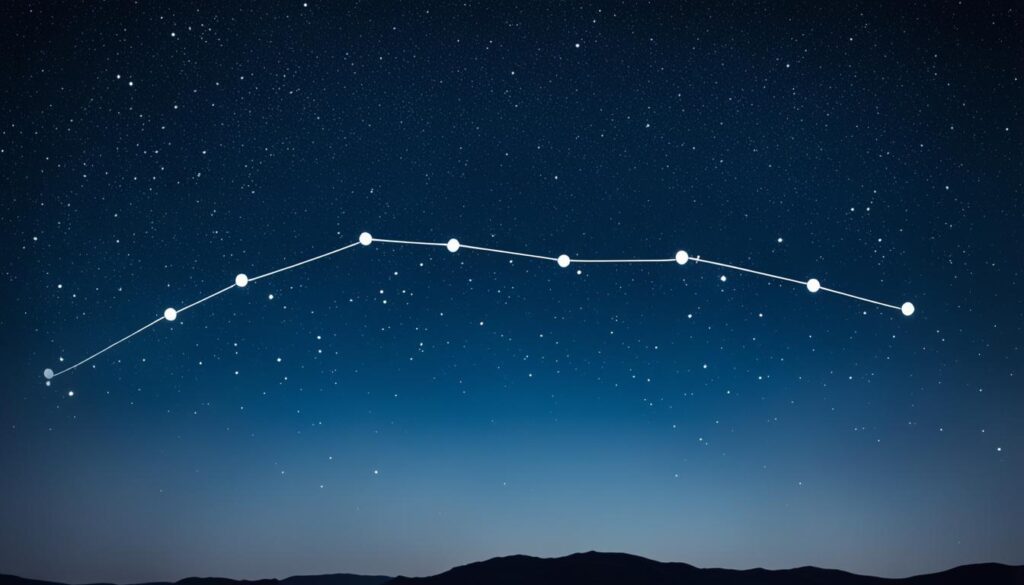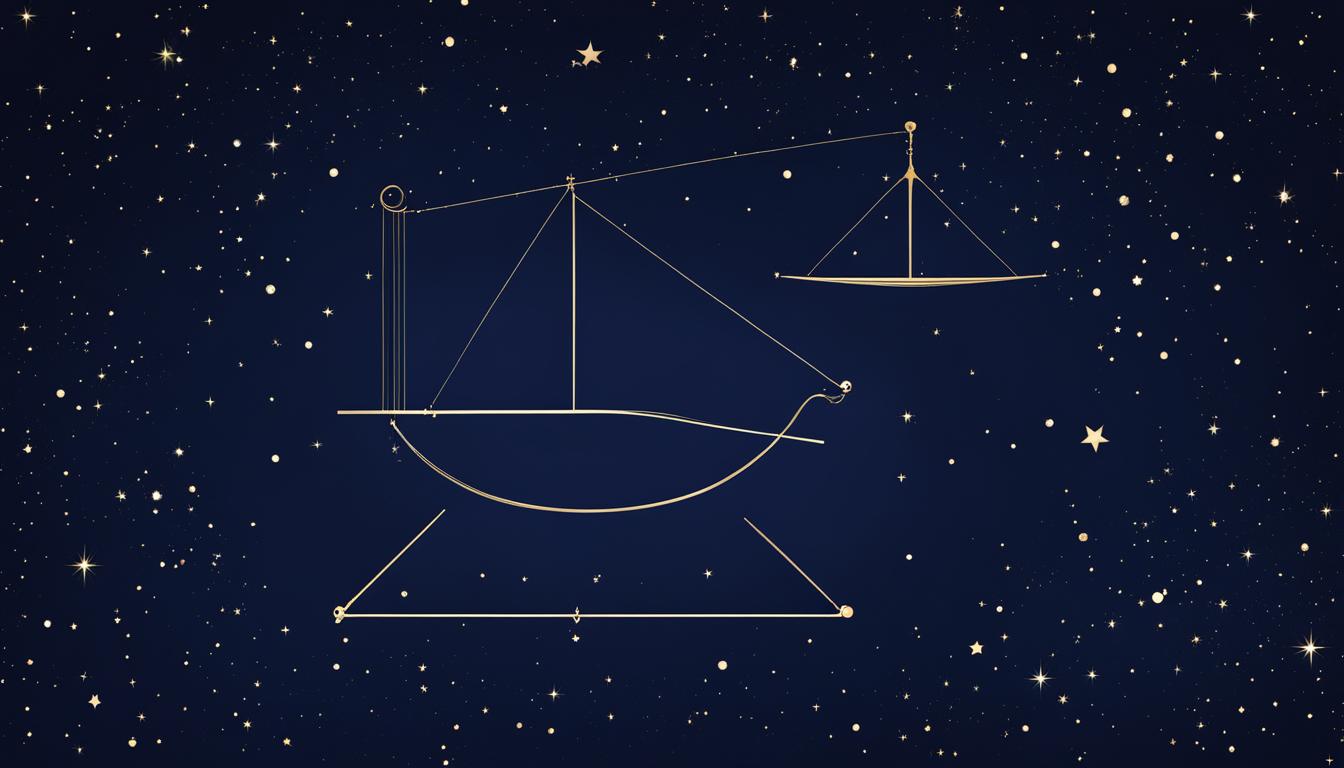| Genitive | |
| Abbreviation | |
| Pronunciation | |
| Main Stars | |
| Brightest Star | |
| Right Ascension | |
| Declination | |
| Sq. Deg. Area | |
| Crosses Meridian | |
| Visible Lat. Range |
Delving into the celestial expanse, you encounter the elegant scales of the Constellation Libra, an archetype of balance amidst the zodiac constellations. Unravel the starry lore etched across millennia, as Libra enshrines the virtues of equilibrium and justice against the backdrop of the night sky. Whether an avid stargazer or a curious wanderer of night’s canvas, this guide promises a profound understanding of Libra’s celestial role and its storied past.
Key Takeaways
- Libra is a unique zodiacal constellation symbolized by the scales of justice.
- Its four brightest stars form a quadrangle that is easily recognizable in the southern hemisphere.
- The Methuselah Star within its bounds is one of the oldest known stars, adding to Libra’s fascination.
- Libra’s best viewing period occurs in June at 9 p.m., offering a celestial spectacle.
- The constellation is steeped in mythology, harking back to ancient civilizations that saw it as a symbol of balance.
- With no first-magnitude stars, Libra still captivates with luminaries like Zubeneschamali and Zubenelgenubi.
- As the only inanimate object in the zodiac, Libra’s presence punctuates the starry lore with its distinctness.
Exploring the History and Mythology of Constellation Libra
As you delve into the celestial tapestry of the night sky, the Libra star sign awaits, a symbol so deeply woven into our past that it transcends mere explanation as a Roman zodiac figure. Its story, told through the lens of cultural astronomy, affords us a glimpse into the collective human experience, where celestial mythology merges with history to reveal a more profound narrative.
The Ancient Origins and Cultural Significance
The Babylonian legacy laid the foundation for Libra’s enduring emblem of balance. It was an aspect so pivotal to their worldview that its representation marked more than the heavens—it signified the very essence of order that governed all aspects of existence. The Greeks, too, had a hand in shaping its story, initially perceiving Libra as an extension of the Scorpio constellation, its claws poised in celestial intrigue.
Roman Influence and the Scales of Justice
It wasn’t until the Romans cast their eyes skyward that Libra began to truly stand on its own. The scales, emblematic of justice, found favor within the pantheon of Roman deities, aligning themselves with the goddess Dike. This interplay of myth and sky, justice and stars, positioned Libra as a touchstone of harmony, echoing the Roman yearning for an equilibrium reflected both on Earth and in the heavens.
Transition from Claws to Scales: A Celestial Elevation
Remarkably, the transition of the autumnal equinox from Libra in 729 did little to diminish its standing. The scales, once seen as mere appendages of Scorpio, ascended to a station of singular respect. This celestial elevation expresses our evolving journey of astronomical discovery—a journey that continues to fascinate and expand our understanding of both the universe and ourselves.
| Civilization | Representation | Celestial Association |
|---|---|---|
| Babylonians | Balance | Order and Justice |
| Greeks | Scorpio’s Claws | Power and Conflict |
| Romans | Libra Scales | Justice and Equilibrium |
The Astronomical Fundamentals of Libra
As someone keen on Libra astrology and the secrets of the cosmos, understanding the astronomical underpinnings of the Libra constellation can greatly enhance your night sky observations. This celestial guide will illuminate the characteristics that make Libra a captivating feature of our universe.
Positioning and Visibility: From Where and When to Observe
For the best star visibility, Libra graces the night sky most prominently in June. Ideally, your observations should commence at 9 p.m. to witness the constellation in its full glory. Due to its placement in the southern celestial hemisphere, assume a position looking southward away from artificial light sources to spot Libra’s subtle configuration against the canvas of stars.
Brightest Stars and Their Cosmic Stories
The luminaries of Libra are not only significant for their brightness but also for the ancient stories they convey. The constellation’s brightest stars, Zubeneschamali (Beta Librae) and Zubenelgenubi (Alpha Librae), symbolize the scales’ balance beam. Despite none of Libra’s stars being first magnitude, Beta Librae stands out with an apparent magnitude of 2.61. Furthermore, Zubenelgenubi is part of a fascinating binary system, shedding light on the inherent duality present in celestial positioning.
| Star Name | Apparent Magnitude | Notability |
|---|---|---|
| Zubeneschamali (Beta Librae) | 2.61 | Brightest star in Libra, known for its distinct blue-green hue |
| Zubenelgenubi (Alpha Librae) | 2.75 (Combined) | Nearest bright star to the ecliptic in Libra, binary system |
| Brachium (Sigma Librae) | 3.29 | Orange giant featuring a rich spectrum, manifesting stellar evolution |
| Zubenelakrab (Gamma Librae) | 3.91 | Visual binary star, with a pair distinguishable through telescopes |
Understanding the celestial positioning of these stars can provide a more enriched experience of the Libra constellation. Whether you’re a dedicated amateur astronomer or just love to gaze at the night sky, knowing where to find Libra and its stars can make your stargazing sessions more fascinating and fulfilling.

Main Features of the Constellation Libra
Delving into the Libra constellation, you’ll discover an exceptional composition in the night sky that firmlly grips the interest of astronomers and zodiac enthusiasts alike. The constellation’s array of stars includes the alpha and beta stars, each contributing to its status as one of the most identifiable constellations. And, it’s not just any part of the zodiac but holds the unique distinction of being the only representation of an inanimate object, highlighting zodiac uniqueness amidst its celestial peers.

Navigating Key Stars: Alpha, Beta, and Beyond
As you gaze towards the heavens, the alpha and beta stars capture your gaze with their significant luminosity. Brachium (Sigma Librae) and Zubenelakrab (Gamma Librae) are like jewels adorning the Libran scales. Libra’s alpha star, Zubenelgenubi, and its neighboring beta star, Zubeneschamali, form a distinct dichotomy in brightness and are integral to the constellation’s famed balance beam narrative. With this guide to the skies, your understanding of Libra horoscope readings may deepen as these stars bear astrological relevance that predates modern interpretations.
Unique Aspects: The Only Inanimate Object in the Zodiac
Amid the depictions of creatures and deities that populate the zodiac, Libra’s portrayal as scales is a solitary yet striking deviation. This peculiarity confers upon Libra a singular place in both astral and mythological lexicons. The scales symbolize equilibrium and justice, reverberating through the ages in various cultures and civilizations. Libra’s influence extends from horoscopic insights to its broader representation within astronomical classifications—the non-existence of Messier objects in its quadrant supplements distinctive traits among its zodiacal counterparts.
Diving Deep into Libra’s Stellar Composition
The night sky holds the Libra constellation, a celestial tapestry interwoven with stories of balance and beauty. As you explore this zodiac sign, the stars exemplify diverse spectral types and host multiple star systems, each contributing to the lush narrative of the cosmos. The spectral classifications within Libra provide insight into the various stages of stellar life, from youthful blue-white dwarfs to seasoned orange giants. It is this variety that furnishes Libra with its enticing personality, one that reflects the dual nature of cosmic balance and intrigue.
Understanding Spectral Classifications
In the ethereal scales of Libra, spectral types reveal the temperatures, luminosities, and sizes of the stars. For example, delve into the science of star classification, and you’ll unearth Beta Librae, a blue-white dwarf star. This stellar enigma spins rapidly on its axis, radiating energy more forcefully than our home star, the Sun. On the opposite end, Gamma Librae, an orange giant, tells a cooler tale, providing a striking contrast in this stellar mosaic and embellishing the nuanced Libra personality seen through the lens of celestial physics.
The Intriguing Tales of Libra’s Multiple Star Systems
Libra’s charm also resides in its captivating, multiple star systems. The binary complexity of Zubenelgenubi offers an enigmatic cosmic puzzle, as this pairing dances in an intricate gravitational choreography. Additionally, the Alpha Librae system sparks debate and curiosity among those who gaze upward, yearning to decode the universe’s complexities. These systems, against the backdrop of the vast night sky, stand as a vibrant homage to Libra’s unique placement in both lore and space. As astronomers continue to unravel these mysteries, the constellation’s tales pique the interest of star gazers and scientists alike, proving the enchanting legacy of star classification and its influence on our understanding of the skies above.
FAQ
What is the constellation Libra and where is it located in the night sky?
The constellation Libra is a collection of stars that forms the shape of scales, symbolizing balance or justice. It is one of the 12 zodiac constellations and is located in the southern celestial hemisphere, best observed from +65° to -90° latitudes. The constellation is flanked by Virgo and Scorpius and can be best seen during June at 9 p.m.
What are the historical and cultural significances of the Libra constellation?
Constellation Libra has roots in ancient Babylonian, Greek, and Roman cultures. Originally seen as part of Scorpio, it was later recognized by the Romans as a symbol of balance and equinoxes. Its cultural significance is tied to the balance of seasons and Roman lore associates it particularly with justice through the figure of Dike or Astraea, depicted by neighboring Virgo.
How did Libra transition from being part of Scorpio to a separate constellation?
Over time, as astronomical understanding evolved, what was once considered to be the claws of Scorpio (in Greek and earlier Babylonian astronomy) were redefined by the Romans as a separate entity embodying the scales of justice. This transition marked Libra’s elevation from being a mere part of another constellation to having its own distinct identity in the sky.
When is the best time to observe the constellation Libra?
The best time to observe the constellation Libra is during the month of June, specifically around 9 p.m., when it is positioned well above the horizon in most locations within its visibility range. This time of year provides optimal darkness and positioning for observing Libra’s stars.
Which are the brightest stars in Libra and why are they significant?
The brightest stars in Libra are Zubeneschamali (Beta Librae) and Zubenelgenubi (Alpha Librae). Despite not being of first magnitude, these stars are significant as they represent the ‘balance beam’ of the scales. Beta Librae stands out for its blue-white luminescence, while Alpha Librae is a binary system, marking the duality within the constellation.
Why is the Libra constellation unique among the zodiac symbols?
The Libra constellation is unique among the zodiac symbols because it is the only one represented by an inanimate object—the scales. This makes it stand out as different from other zodiac symbols, which are typically represented by animals or mythological figures.
What can be learned from the spectral classifications of Libra’s stars?
The spectral classifications of Libra’s stars, which range from blue-white dwarf stars like Beta Librae to orange giants like Gamma Librae, provide insights into the physical properties, temperatures, and evolutionary stages of the stars. Studying these classifications offers a deeper understanding of celestial mechanics and the life cycles of stars.
What are the multiple star systems in Libra and why are they interesting to astronomers?
Libra hosts several multiple star systems, including the binary pairs of Zubenelgenubi (Alpha Librae) and some debated components of the Alpha Librae system. These systems are of particular interest to astronomers because they offer a chance to study stellar dynamics, formation, and evolution. The complexity and interactions within these systems also provide valuable data for testing theoretical models of star development.
How does Libra’s mythology relate to its neighboring constellation, Virgo?
Libra’s mythology is closely tied to Virgo due to the representation of Dike or Astraea, the goddess of justice, who is associated with both constellations. The scales of Libra symbolize the justice that Astraea, depicted by the constellation Virgo, upheld. This connection highlights the integration of mythological narratives in the celestial sphere.
What is the significance of the Methuselah Star in the Libra constellation?
The Methuselah Star, also known as HD 140283, is significant because it is one of the oldest known stars in the universe. Located within the bounds of the constellation Libra, this star offers valuable information for astronomers studying the early universe, galactic formation, and the aging process of celestial bodies.






